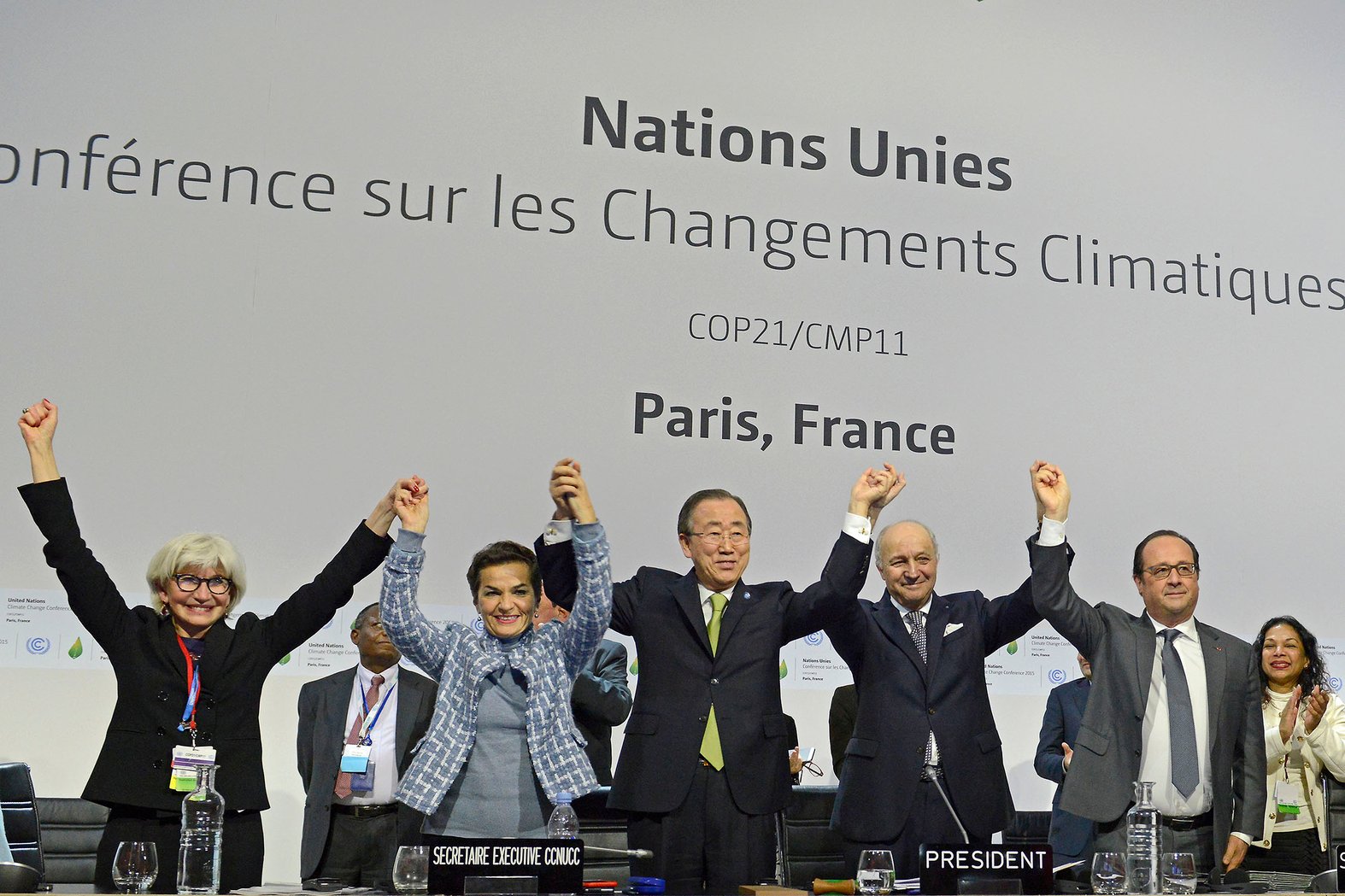
Since the Paris Agreement was signed in 2015, there has been a flurry of 'Paris-aligned' or '1.5°C-aligned' pledges by individual countries, companies and a host of other actors.
All of the governments that signed the accord have submitted their first round of what are known as Nationally Determined Contributions (NDCs)—plans outlining the climate actions they will take in line with their commitments under the Paris Agreement. In a recent statement, G7 leaders also committed to “submitting ambitious 1.5°C-aligned [NDCs].” Oil majors like Shell and BP have also announced plans that they claim are in line with Paris Agreement targets. There are similar Paris Agreement-aligned mitigation pathways for cities around the world and also for specific sectors, like steel.
The ubiquity of this phrasing, on the one hand, makes sense. The central aim of the Paris Agreement is to strengthen the global response to climate change by keeping global temperature rise this century well below 2°C and to pursue further efforts to limit warming to 1.5°C.
But Paris Agreement targets are global goals that require global efforts. There is no agreement on how that effort must be shared among various actors. Thus, no individual actor—be it countries or companies or specific sectors or cities—can unilaterally claim to be ‘Paris-aligned’ without making assumptions about the kind of climate action the rest of the world will take.
In addition to ”Paris-aligned” or “1.5°C-aligned” pledges, many countries, municipalities, states, and private actors have also announced “net-zero” pledges. The Paris Agreement refers to achieving a balance between anthropogenic sources and sinks of greenhouse gas emissions—a concept widely understood as reaching “net-zero.”
But this terminology may also need to be reconsidered, especially when it comes to industry promises since these are voluntary in nature.
These pledges are “questionable at best,” the authors of a new paper published this month in the journal Climate Policy say.
“What we argue in the paper is that as soon as you label your pathway, say ‘1.5°C’, you not only make a statement about what you are going to emit over the duration of that pathway, but also about what the rest of the world emits until 2100. So you are de facto making a statement about the distribution of emissions over time and space,” said Franck Lecocq, lead author of the paper and director at Centre international de recherche sur l'environnement et le développement. Lecocq is also an IPCC author.
The relationship between temperature and cumulative emissions is essentially linear. In other words, rising temperatures are directly proportional to the concentration of CO2 in the atmosphere. Such CO2 concentration is a result of both current and past emissions: some analyses estimate that as much as 90 percent of the carbon budget to realistically limit warming to 1.5°C is already exhausted. Today, the world is around 1.2°C warmer than pre-industrial times.
When an individual actor makes a “Paris-aligned” or “1.5°C-aligned” pledge, the questions that must be asked, Lecocq explained, are “What do you base that claim on? What do you assume you will emit beyond 2045 and until 2100 to reach that goal? What do you assume that the rest of the world emits until 2100 to reach that long-term temperature goal? And so what is your share of emissions (historical and future) in that global pathway towards that long-term temperature goal?”
These questions help make explicit the assumptions that are implicit in the “Paris-aligned” claim.
The distribution of emissions over time is not just a question of cumulative global emissions—it’s also a matter of equity. Rich, industrialized countries have already claimed a disproportionate share of the carbon budget that has brought us to around 1.2°C warming today. The U.S. has emitted about 25 percent of cumulative emissions; Europe, meanwhile, has emitted around 20 percent.
The Climate Policy paper points to issues that arise when individual countries or companies link their efforts to mitigate climate change to Paris Agreement goals. If such linking is indeed necessary, the authors say that assumptions about time scale, spatial scale and equity must be included in the analysis and presented transparently.
The paper is “a welcome contribution” because it asks countries to center mitigation claims in a context of national contributions to global fair shares of the climate response, said Kate Dooley, a research fellow in the School of Geography, Earth and Atmospheric Sciences at the University of Melbourne. At present, many wealthy countries have exceeded their fair share of the carbon budget.
The Paris Agreement recognises that action must be undertaken on the basis of equity. This means, Dooley said, countries should consider how their contributions are “fair” and to outline this in their nationally determined contributions.
“Not all do so and there is no agreement on what a fair share is, but by claiming an individual target is Paris compliant is implicitly making an ethical claim that this represents your fair share of the global response, without saying how it is fair,” she said.
Concluding that “labels become less critical where international cooperation is stronger”, the authors say that there is a need for cooperation and coordination among all actors across countries, regions and economic sectors to ensure that the sum total of individual efforts is consistent with the goals of the Paris Agreement.
Voluntary corporate targets are insufficient
It’s not just countries’ climate pledges that need a terminology overhaul. The phrasing used in voluntary corporate pledges, another new paper shows, is insufficient to assess an individual company’s climate action.
That study, published in Science in April, warns that “voluntary targets, even if claiming to be science based, cannot ensure collective alignment with the climate objectives [of the Paris Agreement] and may delay necessary regulations.” It calls for government regulation of markets to curb emissions and also to foster innovation for decarbonisation.
Net-zero corporate pledges are voluntary, which means they can be reeled back in as quickly as they are announced.
Shell scrapped its emission reduction target for 2035 when it sought to grow its gas business, for example, and BP walked back on some of its climate commitments when profits hit a record high. An Oil Change International assessment of the climate plans of eight oil majors—Chevron, ExxonMobil, Shell, TotalEnergies, BP, Eni, Equinor, and ConocoPhillips—released this year found that all eight continue to drive fossil fuel expansion and six have explicit goals to grow their total production volume this decade.
“Fossil fuel companies including BP and Shell opportunistically published net zero plans a few years ago, only for these to be scaled back when more money could be made by scaling them back,” Joeri Rogelj, the study’s co-author and a professor of climate science and policy at Imperial College London, said. (Rogelj is also an IPCC author.) “This indicates that stated voluntary targets can hardly ever be considered robust.”
Yann Robiou du Pont, a researcher at Utrecht University and lead author of the Science study, explained that while the authors recognize that voluntary emissions targets, including those set by the Science Based Targets initiative (SBTi), may have contributed to lower emissions, “such positive outcomes should not deter regulators from passing regulation that would result in greater reductions by using regularly updated policies that both incentivise innovation and efficiency, and cap the total production or demand, when necessary.”
SBTi is currently the world’s most prominent verifier of corporate climate targets. It publicly “validates” 5500 companies as Paris-aligned based on their declared emission reduction targets. Such validation helps companies build goodwill and attract “green financing.” In 2021, it launched the world’s first “Net-Zero Corporate Standard.”
In April 2024, the organization erupted in scandal when its board sent out a press release announcing it would now be allowing companies to purchase carbon offsets as a way to reduce emissions associated with the use of their product or service (referred to as “Scope 3 emissions”). In response, SBTi staff retracted that news, saying they would evaluate the idea as they do any change to their framework and announce a final decision this summer.
Even if no part of the SBTi framework changes, the Science study states that target-setting approaches like those adopted by SBTi fail to show how a universal adoption of such targets could lead to emission reductions as required by the Paris Agreement.
A major blindspot is the fact that SBTi does not take into account new companies with their share of emissions coming into existence in the future. In SBTi’s framework, existing companies are allocated a share of the carbon budget without leaving any room for new players, some of whom might be more efficient or even working in the decarbonisation space like solar technologies. This further entrenches fossil fuel developments by existing companies and also raises questions about equity.
“These claims assume that a company that pollutes more now should be able to pollute into the future. This means Global North companies will continue to inequitably dominate use of our remaining carbon budget. These findings should raise real questions for any bodies that claim to set standards for voluntary corporate climate targets,” David Tong, Global Industry Campaign Manager for Oil Change International, said.
Much like the paper in Climate Policy that stresses the need for explicit assumptions related to other actors, the paper in Science too notes “only by considering whether an emissions target represents a fair contribution to a global collective action problem can its adequacy be assessed.”


